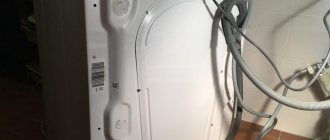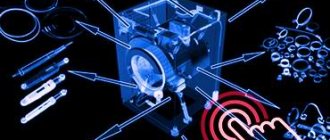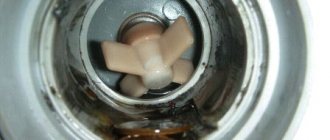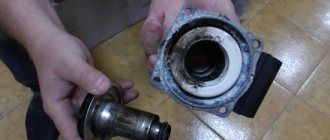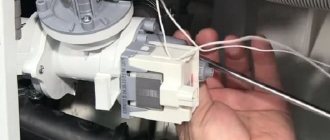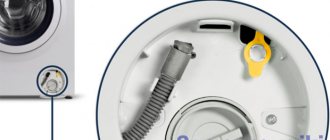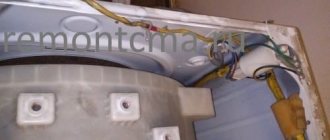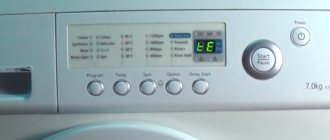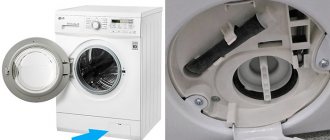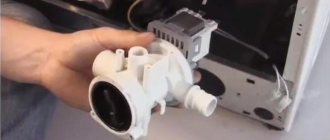Before purchasing a washing machine, the owner first determines where the device will be installed. But sometimes the location has to be changed. Subsequently, difficulties arise with connecting to the water supply and drainage, which are associated with the insufficient length of the inlet or drain hose.
- Types of hoses in a washing machine
- When do you need to lengthen and how much is possible?
- Drain hose extension
- How to extend the inlet hose?
- Expert recommendations
- Catalog of washing machines with reviews
Types of hoses in a washing machine
Hoses in washing machines are used to fill and drain water. The tubes connect the SMA to the water supply and sewerage systems. Kinds:
- Bulk. Water is supplied through it to the washing machine. It can be rubber, reinforced, equipped with the Aquastop system. The reinforcement is made of nylon or metal. They differ in cost and service life.
- Drain. Through it, water is removed from the tank into the sewer pipe. Made from polypropylene with fittings for connection on both sides. Hoses are available in different versions on the market.
Are you unplugging your washing machine?
Oh yes! No
Types:
- Up to 5 m long. They connect well with each other.
- Bays. Susceptible to blockages when used as drains.
- Telescopic. Very convenient in terms of length adjustment.
- With the Aquastop system. They are expensive, but safe to use. Protected from leaks.
What is a drain hose?
An ordinary drain hose, the length of which is clearly fixed, can be 1 m, or maybe 5 m. However, many craftsmen prefer to double the length of the hose. This seems to be done simply: you need to connect two drain hoses to each other with clamps.
For example, a Zanussi washing machine initially has a good long drain hose, but budget models cannot always boast of this and you have to lengthen the hose yourself.
Recently, telescopic drain hoses have been increasingly used . They are sold in compressed form, literally 60 cm. But when you unfold the structure, you get a two-meter hose. True, such compactness has its drawbacks. Such modern hoses are less resistant to blockages. Also, when water drains, these hoses vibrate more. If they are not stretched smoothly each time, cracks are possible, and this is fraught with water leakage. Moreover, it is not a fact that you will notice these cracks until they start leaking.
A more convenient hose model, of course, is a hose in a coil. It also folds out to the desired length, but everything happens within the module. The hose already has notches; the hose can be cut in these places.
By the way, experts advise not to get carried away with lengthening hoses - blockages in hoses that are too long are much more common.
[custom_ads_shortcode2]
When do you need to lengthen and how much is possible?
As a rule, the standard length is no more than 2 m, but usually about one and a half. If it is less, the drain hose will need to be extended.
Sometimes this needs to be done due to the location of the machine in the room and the location of the sewerage and water supply taps. Alternatively, you can purchase a longer one as a replacement.
Expert opinion
I work in the household appliance repair industry. Extensive experience in restoring washing machines and dishwashers.
Ask a Question
Important! Preference should be given to purchasing in specialized stores and supermarkets.
To replace it, you will need to disassemble the machine, which requires certain skills and knowledge. You can extend the drain without disassembling the housing by connecting 2 (new and existing) together.
Drain hose extension for washing machine
Manufacturers of washing machines install standard drain hoses about 1.5 meters long on their products. In most cases, this is enough, and if you correctly plan the sewerage supply to the washing machine or install a hidden siphon for the washing machine, then there should be no problems with the length of the standard hose. But it often happens that the hose is too short, or the sewer pipe is too far away and the standard length is not enough. What to do in such a situation?
In order for the drain hose to become longer, there are two methods, which differ in the complexity of implementation:
Method one: you can buy a longer one-piece hose and replace the whole thing. But in this case, you will need to tinker a little and unscrew some parts of the washing machine. In some washing machine models this is easier to do; in some you will even have to remove the front wall. Therefore, this option for extending the drain hose is not very convenient and will not be suitable for many. And why actually bother if you can make everything much simpler.
Method two: You can simply buy an additional hose for the washing machine and a connector in the store. Use this to lengthen the drain. It is this method that we will consider in more detail.
Drain hose extension
The standard length of drain hoses for automatic washing machines is from one and a half to two meters. To install longer ones, the SMA must be disassembled. This is the only way to make a replacement.
Drain hose
Decide on size
You will need to use a tape measure to measure the distance required for connection. It is necessary to do this without tension so that the hose is not strained. It is better to provide a slightly longer length.
Elastic pipes of various diameters and sizes are available on the market, so choosing the right one is not difficult. If you need to extend the drain hose, the main thing is to know when to stop.
Expert opinion
I work in the household appliance repair industry. Extensive experience in restoring washing machines and dishwashers.
Ask a Question
Important! If the total length is more than 4 m, the pump may not pull. The pump does not always have sufficient power. When extending the drain hose, do not forget that the upper attachment point should not be at a height of more than 1 m. Otherwise, problems with water drainage may occur.
In addition, this size leads to increased wear on the pump and premature failure.
Selecting a Special Connection
The fittings look like small plastic tubes. They are attached to the end of the hose and secured with a clamp. The sizes come in different sizes - from 1.6 to 2.7 cm. Therefore, they are selected in accordance with the diameter of the hose.
You can replace the special connector with a regular plastic tube, which is secured with a clamp. But it’s better not to do this, because it leads to leaks and problems with neighbors.
drain hose extension fitting
Tools and materials
In order to extend the drain hose of the washing machine, you need to prepare everything you need in advance. To complete the task you will need:
- New hose.
- Good quality clamps.
- Connecting elements.
- Screwdriver.
It is not necessary to buy clamps; you can do without them, but if they are present, the connection will be more reliable and tight. They are also indispensable in the absence of a good connector.
Elongation
After everything is prepared, you can proceed directly to work. First you need to put on the connector and attach a clamp to it, which is tightened with a screwdriver. In this case, the tension should not be too tight.
Expert opinion
I work in the household appliance repair industry. Extensive experience in restoring washing machines and dishwashers.
Ask a Question
Important! The hose will remain vulnerable at the connection points, so it must be positioned in such a way that they do not come into contact with anything.
drain hose extension
Connection to drain
The final stage of work on extending the hose is preparing for use of the washing machine. To do this, you need to connect the drain pipe to the sewer directly or through a siphon.
The easiest way is to lower one end into the bathtub or toilet, preferably securing it with a holder. Then start the washing process and check the quality of the connection for leaks.
How to extend the drain hose
There are two ways to increase the length of the drain for a washing machine.
- Buy a long, hollow tube and replace the drain completely. This method is not very convenient, since to replace it you will have to disassemble the parts of the washing machine. In some models it will be enough to unscrew one mechanism, but in others it will be necessary to disassemble even the body and the front wall.
- Select an additional washing machine drain hose and mounting hardware. This method will be much simpler, will not require significant financial costs and will take less time.
How to choose the length
To properly extend the washing machine pipe, you will need an additional polypropylene drain hose. It is sold in any plumbing supplies department.
Using a tape measure, measure the distance from the washing machine to the sewer. You need to measure so that the tape measure hangs freely. The elements cannot be attached to the tension, so leave a small margin of a few centimeters in length.
Plumbing stores have a wide range of extensions for washing machine hoses. They are made in different lengths: from 1 m to 5 m. They are modular, and you can cut them to the desired length. For a standard washing machine, a fixed size drain pipe will fit.
Don't buy a tube that is too long. Pumping water over long distances can quickly cause the drain pump to break down. For the same reason, do not extend the drain pipe more than 3.5 meters.
Necessary elements for extension
Having chosen the length, you need to purchase a few more parts:
- adapter,
- clamps measuring 16x27 mm.
The ends of one hose for draining water from a washing machine are different in size: one is 19 mm, and the other is 22 mm. You need to attach the thin end to the larger hole of the extension tube. For this purpose, you need to choose a carved connector, measuring 19 by 22 mm.
Extending the drain hose
- Disconnect the washing machine from the power supply.
- Connect the drain pipe and the purchased hose from the washing machine, secure them with an adapter. The joints of the ends must fit tightly and hermetically to each other so that water does not leak through them. The connection points must correspond to the markings on the connecting device.
- Install and secure the rubber tips with clamps. Ensure maximum tightness to prevent possible tears. If you use a plastic connector for fastening, then place a small piece of pipe in it, and only then install the clamp.
- Check the tightness of the fasteners. To be sure, you can coat the joints with sealant.
- Remove all kinks and kinks. Reconnect the washing machine to the network.
Online diagnostics of a washing machine
If your machine stops washing or rinsing clothes normally, then some kind of malfunction or breakdown has occurred.
You can try to find the problem yourself. Run diagnostics
Select which operation your washing machine does not perform:
1. Doesn’t drain 2. Doesn’t rotate the drum 3. Doesn’t spin clothes 4. Noises, knocks, buzzes when spinning 5. Doesn’t turn on
Checking the operation of the drain pump Is the drain pump of the washing machine working? Yes No I don’t know << Back
Clogged hoses in the washing machine If the sound corresponds to the normal sound that has always been observed when the device is working, the cause is probably a clog.
Was there a blockage in the drain hose? Yes
<< Back
The drain pump does not work! If the sound matches the normal sound of the drain pump, it is recommended that you check the drain filter first.
After cleaning, does the drain pump work and does the washing machine drain water? Not really
<< Back
Operation of the drain pump The sound of the pump is usually immediately audible and noticeable. If there is no sound, the pump is not working. We are looking for how to separately enable the water drainage program. As a rule, this is a separate option. After the program has been turned on, the pump should start working in 1-3 seconds. If everything is done correctly and the pump is operational, a buzzing sound will appear. If you hear no buzzing or other sounds when you turn on the program, the pump is probably faulty.
Is the washing machine drain pump working? Not really
<< Back
Clogged car hoses If you have identified a clog in the hoses, you need to disassemble them, clean them, and then reassemble everything.
Does the washing machine drain well? Not really
<< Back
Hurray, you did a great job, you fixed it.
<< Return to the beginning of diagnostics
The drain pump is faulty, call a professional.
<< Return to the beginning of the diagnosis.
The washing machine does not rotate the drum. During the operation of the washing machine, such a problem may occur. Each model has a different drum operation. It rotates according to a given algorithm, which is set by the program. This principle applies to spinning and washing. If you are not sure whether the drum is not spinning or whether it is working, put the laundry in the washing machine. Start the spin program. If the machine is running, it will first drain the water and then start spinning. In this case, a rotational process will be observed. If rotation is not visible, then check the belt. First, turn off the program, then unplug the wire from the outlet so that power does not flow into the device. Now you need to remove the back cover. You will need to carefully inspect the drum belt. It is quite easy to determine whether it is in the wrong position or damaged.
Is the washing machine belt torn or stretched? Not really
<< Back
Broken drum drive belt If the belt breaks, it will be immediately visible. There are also often cases when the belt simply stretches, which is why the drum, accordingly, does not rotate. Do not allow the machine to operate if the belt breaks. It is important to check whether it has wound around the engine pulley or broken the wiring to the engine. The heating element and temperature sensor may also be damaged if the belt does catch the wires. It is imperative to ensure that the belt model is original. If you choose an unsuitable or low-quality product, this will affect the performance of other devices. How do you know what kind of belt you have? There will be a marking written on the old one, compare it with the one indicated on the belt offered to you. You can also find out belt information by car model.
<< Return to the beginning of the diagnosis.
Washing machine motor malfunction If a malfunction is not found, the block with wires must be disconnected from the electric motor. Carefully remove it. We visually evaluate the engine. It may have melting, cracks, or other effects that clearly indicate damage. We call the windings of the tachogenerator and the engine. It is important to understand that you can fully study how correctly the engine operates and whether there is a malfunction only at the stand. If rotation does not occur, there may be a problem with more than just the motor. Sometimes the cause is a malfunctioning electronic module. If a short circuit occurs in the engine, the module could be damaged, while the engine remains operational. Also, the wires could be damaged.
<< Return to the beginning of the diagnosis.
Repairing a washing machine that does not spin clothes After completing the washing process, the washing machine may not spin properly or may not start spinning. Firstly, look, perhaps another mode is set, which does not involve turning on the spin cycle at all. This happens, for example, with programs related to washing woolen items and delicate fabrics. To check, run the spin cycle separately. If the washing machine does not drain water, we proceed to check the pump.
Does the washing machine now spin clothes? Not really
<< Back
Congratulations, you have solved your problem!
<< Return to the beginning of the diagnosis.
Repair of washing machines, imbalance Modern washing machines place the laundry on the drum before spinning. This is necessary for quality work. Check if this feature works. Sometimes a situation occurs when things get wrapped up in a ball that cannot be unwound automatically within a certain time. At this point the work stops. You need to unwind this laundry yourself, lay it out and continue operating the washing machine. In this case, it is important to turn off the machine, and then, when the laundry is laid out, turn on a separate spin program.
Does the washing machine now spin clothes? Not really
<< Back
Washing machine repair, drum drive repair Now you need to check the drum drive belt. We remove the cover and visually assess the condition of the belt. There should be no damage. If the tension is weak, the spin may not turn on. If you need to replace the belt, you should only replace it with the original one. After replacing, we try the program again.
Fault found, does the washing machine spin? Not really
<< Back
The engine or electronic module is faulty, call a repairman to your home.
<< Return to the beginning of the diagnosis.
The washing machine hums, makes noise during the spin cycle, rumbles, and makes a jet plane noise. If the washing machine makes noise during operation, making unusual sounds, it’s time to pay special attention to it. In this case, a visible breakdown or lack of functionality may not be observed, but the appearance of strange sounds indicates that it is time to look for a malfunction. It is important to understand that a new car that has just been delivered should be inspected for shipping bolts. If you forget to remove them, noise and vibration are inevitable. So, let's begin! We turn the washing machine drum and listen to extraneous sounds.
When rotating, do you hear extraneous noise, hum, balls rolling, does the drum move unevenly with slight jamming? Not really
<< Back
If the drum rotates and uncharacteristic sounds appear, including vibration, it’s time to check the bearings. If they malfunction, they will have to be replaced.
<< Return to the beginning of the diagnosis.
The counterweight of the washing machine has come loose. The fastening of the counterweights must also be of high quality. If they are “loose”, it’s time to eliminate this defect. In some cases, you can notice that the bolts that secure the stones are completely missing. In this case, the connectors for mounting will be visible. The bolts need to be found and put in place - they probably simply came loose. A rumble heard while the washing machine is operating may indicate that the bolts have partially loosened. To check the bolts, you can simply push the drum. If it is secure, the bolts are fine. If it moves, there is a defect.
Do you hear any noise, clanging or rattling noises when moving the washing machine tub? Not really
<< Back
The counterweight has come off
<< Return to the beginning of diagnostics
Checking the shock absorbers of the washing machine Checking the shock absorbers. If you hear vibration or excessive noise during the spin cycle, there may be a problem with the shock absorbers. Sometimes the washer moves. Now let's check the functionality. Remove the top cover. Click on the tank, move it five to seven centimeters down. A normal reaction will be observed if the tank rises sharply, jumping a little and stopping in its normal place. If this does not happen, the shock absorbers need to be replaced.
Are the shock absorbers of the washing machine working? Not really
<< Back
If a visible defect has not been identified, check whether a foreign object may have entered the machine. Replacing shock absorbers. The problem with shock absorbers wearing out occurs quite often over time.
<< Return to the beginning of the diagnosis.
Replacing washing machine shock absorbers. Malfunction and wear of shock absorbers is a fairly common phenomenon.
<< Return to the beginning of the diagnosis.
The washing machine does not turn on. It is worth trying to find the cause of the problem yourself and fix it. We start by connecting the device to the network. Next, click on the “network” button. In different car models, different indications are triggered: here either the display will start working, or, on the contrary, some other button.
Does the washing machine have an indicator? Not really
<< Back
Hatch lock lock (UBL) You can check it by turning on any of the programs. We choose what we will use. Click on the corresponding button. Don't forget to pay attention to the inclusion. As a rule, the process of activating a function is characterized by the presence of a certain sound, for example a click, with which the device makes it clear that pressing again is not necessary and the machine is already working. If there is no sound, the button may be broken. In this case, the main thing that must be done is to block the hatch and start working. If this happens, everything is fine.
The washing machine is blocking the hatch and the UBL is triggered? Not really
<< Back
Water fill valve malfunction
<< Return to the beginning of the diagnosis.
The washing machine hatch does not lock
<< Return to the beginning of the diagnosis.
No indication Checking the electrical circuit. If you notice that the washing machine does not respond to being turned on, it is first recommended to check the power supply. The outlet may be faulty. Try connecting another device. If the outlet works, you need to check whether the circuit that conducts energy through the washing machine from one element to another is intact. To do this, you will need a multimeter, which will help you fully analyze the ability to respond to an electrical signal at several stages of operation. If there is no network connection anywhere, this is probably the problem. We carry out this manipulation until we reach the electronic module. If we are talking about an old washing machine, here it will look like the device’s program. When you turn on the button, there should be no breaks in the circuit. If the circuit works, everything is fine electrically.
Is the washing machine's power supply OK? Not really
<< Back
Repair of electronic module (unit)
<< Return to the beginning of diagnostics
Contact circuit fault
<< Return to the beginning of diagnostics
How to extend the inlet hose?
Extending the inlet hose is no problem. The easiest way is to purchase a larger part than may be required. This can be done at a plumbing store.
The market offers a large selection of parts for every taste. There is no need to disassemble the washing machine for this.
fitting for extending the inlet hose
Step-by-step instruction:
- Disconnect the SMA from the power supply and water supply.
- Unscrew the fastener according to the type.
- Replace the hose and secure without using tools.
- Open the valve and make sure the connections are tight.
- Check the quality during the washing process.
If you don't have the correct size hose, you will need an extension. For this you need another hose and adapter.
This is done using a brass nipple measuring 3 to 4 inches. Extension is carried out by screwing a nipple onto each of the elements.
Connecting the inlet hose
How to lengthen?
Standard hose sizes are one and a half to two meters. There is an original way to increase them - purchase an element of suitable length and replace it. The task is made easier by the fact that stores have options that differ in different lengths. To perform the replacement, you will have to partially disassemble the washing machine.
If you don’t want to tinker for a long time, use a simpler method of extending the hose by adding a purchased hose of suitable length to the old element. The connection is made with special clamps.
By the way, it is allowed not to use clamps if the drain elements are connected tightly using a special adapter. The process is simple - pieces of hose are pulled tightly onto its ends and secured with clamps for insurance. If there is no suitable element for connection, you can use thin plastic tubes with a diameter suitable for the cross-section of the hose. The drain hoses are stretched so that their junction is in the middle of the tube, and fastening clamps are installed. For your washing machine to function normally, the length of the drain element should not exceed three and a half meters.
If possible, move the washing machine closer to the water intake point and sewer system. You can invite a plumber to move the connection point of the drain hose closer to the washing machine. If the sewage system in your apartment is made of plastic pipes, then you can easily do this kind of work on your own.
The water intake hose is also easy to change - an element of the appropriate length is purchased, it is replaced, and the washing machine is tested for the tightness of the filling system.
Expert recommendations
Before increasing the length of the drain hose, it is important to consider the necessary parameters. It should be remembered that the mounting height of the upper point should not exceed 1 meter, otherwise the drainage pump will not cope with pumping out the used water. Neglecting these points will lead to difficulty draining water from the tank.
When connecting, you should pay special attention to the free tension of the pipe, taking into account the location of the upper fastening. The height should not exceed 0.6 m from the lowest point.
This rule applies to connecting all automatic washing machines, regardless of the company. However, you should not neglect the manufacturer’s recommendations, which are stated in the instructions.
Extending the hoses of a washing machine to drain and fill water does not present any difficulties for the average user. You can do this yourself without spending a lot of time and effort.
Video
Necessary parts and tools for extensions
Before you start extending the drain hose, you need to buy the necessary devices and tools.
The main element is a rubber hose, the length of which should be determined in advance. The distance between the entrance to the water drain and the washing machine must be measured using a tape measure. The pipe should not be stretched, so it is better to allow 2-3 cm. It is recommended to buy a longer part, the excess can be easily removed.
Repair experts advise that the maximum length of the washing machine drain hose should be no more than 3.5 meters. The drain pump does not have enough power. The length of the hose directly depends on the electricity consumed, because the pump will operate at full capacity. This often leads to breakdown.
Therefore, it is important to correctly determine the required length, without stretching.
To connect the drain hose of the washing machine to each other you need to:
- 2 clamps 27 by 16 cm;
- coupling (connecting part).
It is a plastic tube for connecting hoses to each other. The diameter of the pipes is not equal. One side is 19 mm, the other is 22 mm. The edge of the smaller diameter is intended for connection to the water sewer system, the larger one - to the drain pump.
An alternative to a purchased adapter is a piece of pipe of the appropriate diameter. Properly secured with metal clamps, it will serve no worse than a store-bought one. In addition to the adapter and clamps, you will need a screwdriver. It is needed to clamp “reinforced fasteners”. The hoses must be connected with a narrow and wide end using a carved coupling.
